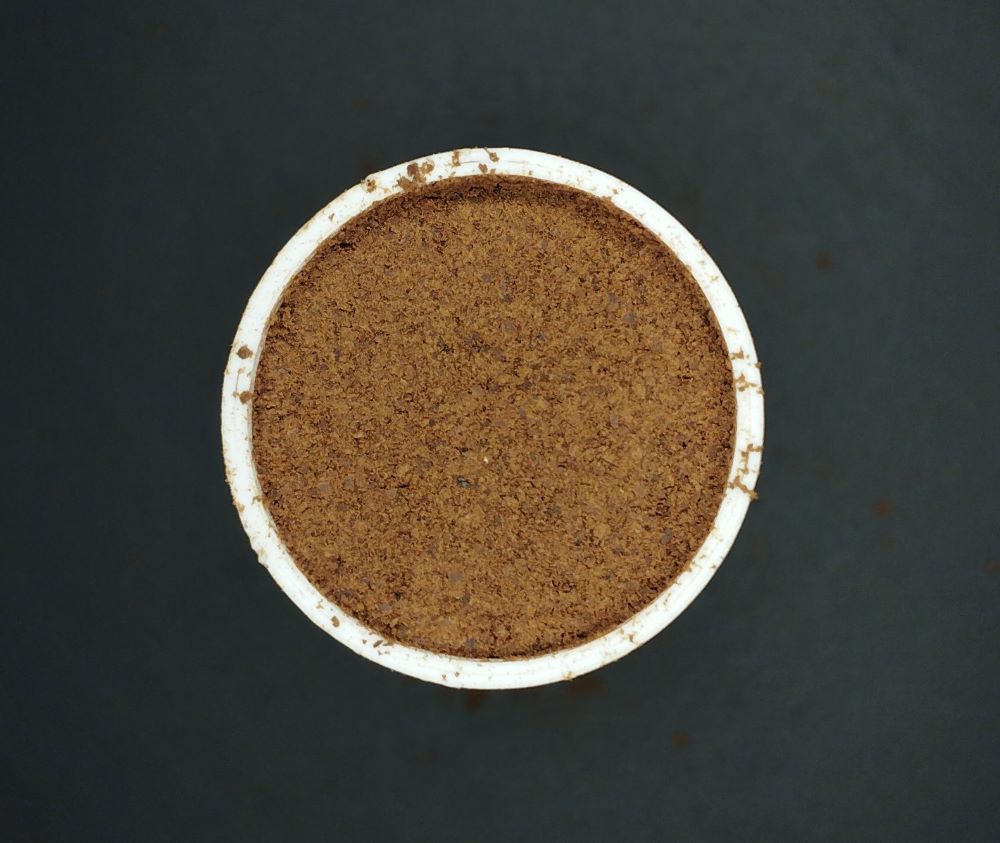


Cell phone attached to a 3D-printed box for capturing images of coffee samples (photo: Michel Rocha Baqueta)
Published on 07/28/2025
By Karina Ninni | Agência FAPESP – Brazil is the world’s second-largest producer of Coffea canephora coffee beans and one of the largest producers of knowledge on the subject. For example, during Michel Rocha Baqueta’s Ph.D. studies at the Faculty of Food Engineering at the State University of Campinas (FEA-UNICAMP), ten articles were published in various international scientific journals.
In one of these articles, Baqueta and his colleagues used digital images obtained with a regular cell phone to authenticate the geographical origin of Canephora coffees produced by indigenous peoples in the state of Rondônia and to detect product adulteration.
“Our method is based on the RGB [red, green, and blue] system, which allows color coordinates to be obtained on electronic devices such as cell phones through an image, for example. The photo is taken by placing the sample [ground coffee] in a device designed with 3D printing technology coupled to a cell phone. The device was designed to keep the analysis under controlled lighting conditions and standardize the distance and other variables that are important in this type of test. The photos contain physical information about the samples, including colorimetry measurements. We extracted these color coordinates in the data science program we use and created a predictive model. From this, we were able to create a signal that provides information about that sample and train the model. This is called machine learning. We have a huge group of authentic and non-authentic samples and have created a database. When we had the model ready and ‘trained,’ we tested the remaining samples – we already knew which ones were adulterated and with what. The characteristics of the coffee appeared in the image and our software was able to capture them. The model was correct 95% of the time,” says Baqueta.

Image of coffee sample captured by cell phone for analysis (photo: Michel Rocha Baqueta)
Professor Juliana Azevedo Lima Pallone from UNICAMP explains that this specific model was created for these Canephora coffee samples and adulterants, such as Arabica coffee (Coffea arabica), coffee grounds, low-quality Canephora coffee, coffee husks, acai seeds, corn, and soybeans. However, it can be adapted. “Based on information about coffee adulteration, we produced adulterated samples in the laboratory and developed the techniques. The model can be adapted to detect ‘fake coffees,’ it just needs to be adjusted and ‘trained’ with other samples and other adulterants,” she says.
The other studies by Baqueta and his colleagues are based on chemical analyses supported by different instrumental analytical techniques and the sensory characteristics of Canephora coffees produced by coffee growers in the states of Rondônia (both indigenous and non-indigenous), Espírito Santo, and Bahia. His doctoral thesis provides information on how metabolites, essential minerals, sensory properties, and spectral properties contribute to identifying the origin and particular characteristics of Canephora coffees in Brazil.
Coffee from the Canephora species, including the Robusta and Conilon varieties, has traditionally been used in blends or for producing instant coffee. Until recently, it was considered lower quality. Canephora is a resilient species that thrives in tropical regions. It has gained new prominence, especially in Brazil, which is already the world’s leading producer of Arabica coffee. Brazil is now setting the standard for quality Canephora coffee.
Specialty coffees are classified based on their sensory characteristics. However, sensory testing is not effective for geographical indication or product provenance because it does not provide information about the coffee’s origin. The studies by Baqueta and his team sought to overcome the difficulties associated with authenticating specialty Canephora coffees, especially those with a geographical indication or designation of origin, as these coffees are beginning to appear on the market.
Indigenous
According to Baqueta, one of the key points is that the Canephora produced by indigenous people in Rondônia has unique qualities and characteristics that differ greatly from coffees of the same species produced in the same state or in other regions of Brazil. “The integrated study of metabolites, inorganic fractions, spectrochemical information, and sensory profile analysis showed how Amazonian terroirs impart unique characteristics to Canephora coffees grown by indigenous people, differentiating them from other coffees produced in the Amazon region and elsewhere. This is related to cultivation and environmental conditions, as well as land use,” reveals Baqueta.
He adds that his thesis is the first in Brazil to chemically study coffee grown by indigenous people. “The partnership between EMBRAPA [the Brazilian Agricultural Research Corporation] and the indigenous people of Rondônia dates back to around 2015, and coffee takes three years to produce. These are the first data of this kind we have in Brazil. And they indicate that this coffee has high potential for the premium market.”
Funded by FAPESP through three projects (19/21062-0, 22/04068-8 and 22/03268-3, Baqueta’s work also showed that the Canephora varieties from Espírito Santo, Bahia, and Rondônia (the main producers of the species in Brazil) are chemically distinct from all the Arabica varieties evaluated by the team. “In our sample, we had special Arabicas and special Canephora varieties from several states. Sensory-wise, the Canephoras we evaluated are comparable to Arabicas in terms of the score that defines specialty coffees. They can be sold as specialty coffee.”
According to the international classification system developed by the Specialty Coffee Association of America (SCAA), the final score of a beverage ranges from 0 to 100. Coffees that achieve a final score higher than 80 points are considered specialty coffees. Those between 70 and 80 points are considered fine commercial coffees. Beverages that score between 60 and 70 points are considered commercial, and those that score 60 points or below are considered inferior.
Data science
Using advanced chemical analysis and data science techniques, the scientists identified important patterns and variables among Brazilian Canephora coffees that distinguish them from each other and from Arabica coffees. “The central idea was to study the performance of the various analytical techniques and which would be the best for identifying the origin, verifying the authenticity of the indication of provenance, and classifying Brazilian Canephoras, which are beginning to appear in the specialty coffee market. The comparisons were made using tools involving data science, because the amount of data to be processed is immense. We indicate the best way to authenticate the products by linking this process to the chemical composition of organic and inorganic compounds in Canephoras,” summarizes Pallone.
Among the various techniques used is spectroscopy in the near and mid infrared regions, including portable equipment. The scientists also worked with the visible ultraviolet spectrum, atomic absorption spectrometry (a technique that provides information about the minerals contained in coffee), mass spectrometry (which reveals the organic composition), and nuclear magnetic resonance (which is usually used to identify secondary metabolites). All of these techniques were applied in conjunction with chemometric tools, which are statistical or mathematical methods used to interpret chemical data.
“In some cases, we work with an extract that’s as close as possible to the beverage that people consume. And for other evaluations, we use roasted coffee powder to perform a direct chemical analysis,” explains Baqueta. The team took this approach to identifying origin and provenance, as well as detecting adulteration, with a view to incorporating the technology into the industry’s processes, internal quality control, and even for exporting. “We did part of the work with green coffee, which is exported. The idea was to create methods that could be used by producers and certification agencies.”
Adulteration
The group paid special attention to detecting adulteration, but reversed the roles since, until now, studies on the subject in Brazil have focused on Canephora as an adulterant of Arabica.
“What if soybeans, Arabica, corn, coffee husks, among others, are used to alter special Canephora coffee? Our methods were able to identify up to 1% adulteration, which is a very low, very subtle level. We were able to detect impurities that were added as adulterants in special Canephora coffees from Rondônia and Espírito Santo and demonstrate that Canephora from Espírito Santo itself could be used to adulterate Conilon coffee from the Amazon. The analytical techniques applied made it possible to identify the alteration of Conilon from Espírito Santo as if it were coffee from indigenous lands in the Amazon, should this occur,” Pallone points out.
She reveals that an adulterant that has emerged in recent years is roasted acai seeds. “We were able to detect adulteration from acai seeds, coffee husks, soybeans, corn, and low-quality Canephora in special Canephora coffees. We prepared several adulterated samples in our laboratory with different proportions of adulterants, tested them, and verified that the models worked in all cases.”
Fake coffee
Due to factors such as climate change, production fluctuations, and increased global demand, coffee prices have been rising. According to the scientists, this scenario favors fraudulent practices, such as adulterating coffee with cheaper non-coffee ingredients. This compromises the product’s authenticity and deceives consumers, who pay more for a drink that does not meet the expected standard.
“In addition, we can already see recipes being shared on social media in which alternative raw materials are roasted to the point of charring, with the aim of creating a drink to replace coffee. This practice raises concerns for professionals in the areas of quality control and food safety, as improper roasting can lead to the formation of toxic compounds,” Baqueta warns, noting that fake coffee has become a growing concern because the effects of its consumption on the body are unknown.
He believes this reality reinforces the need for advances in analytical methods to detect fraud and for stricter regulations to ensure transparency and quality in the production chain.
The ten articles published by the group are available at:
“Multiplatform Path-ComDim study of Capixaba, indigenous and non-indigenous Amazonian Canephora coffees” (Food Chemistry): www.sciencedirect.com/science/article/abs/pii/S0308814624031352?via%3Dihub.
“Enhancing mass spectrometry interpretability by ComDim-ICA multi-block analysis: Geographical and varietal traceability of Brazilian Coffea canephora” (Talanta): www.sciencedirect.com/science/article/abs/pii/S0039914024013067?via%3Dihub.
“Independent components–discriminant analysis for discrimination of Brazilian Canephora coffees based on their inorganic fraction: A preliminary chemometric study” (Microchemical Journal): www.sciencedirect.com/science/article/abs/pii/S0026265X23012225?via%3Dihub.
“An overview on the Brazilian Coffea canephora scenario and the current chemometrics-based spectroscopic research” (Food Research International): https://www.sciencedirect.com/science/article/abs/pii/S0963996924009360?via%3Dihub.
“Authentication of indigenous Brazilian specialty canephora coffees using smartphone image analysis” (Food Research International): www.sciencedirect.com/science/article/abs/pii/S0963996924012031?via%3Dihub.
“Spectroscopic and sensory characterization of Brazilian Coffea canephora terroir and botanical varieties produced in the Amazon and Espírito Santo implementing multi-block approaches” (Journal of Food Composition and Analysis): www.sciencedirect.com/science/article/abs/pii/S0889157524004769?via%3Dihub.
“Brazilian Canephora coffee evaluation using NIR spectroscopy and discriminant chemometric techniques” (Journal of Food Composition and Analysis): www.sciencedirect.com/science/article/pii/S0889157522006834?via%3Dihub.
“Authentication and discrimination of new Brazilian Canephora coffees with geographical indication using a miniaturized near-infrared spectrometer” (Food Research International): www.sciencedirect.com/science/article/pii/S0963996923007615?via%3Dihub.
Source: https://agencia.fapesp.br/55455